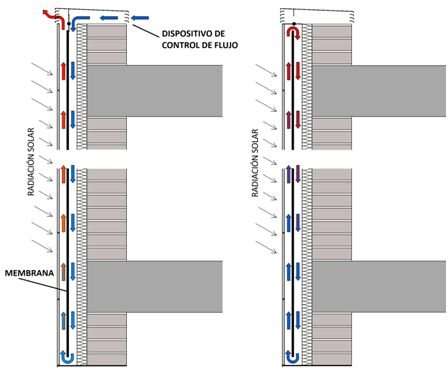New facades enhance energy efficiency of buildings

Recently, two researchers from UPM have developed a ventilated façade with a double chamber and flow control device that significantly saves energy in buildings. This sustainable, efficient solution can be applied in both renovations and new buildings due to its simplicity.
The facade is the main constructive element of a building to meet the requirements of energy efficiency and interior comfort. The type of system, the design and the right execution of the façade itself are critical aspects that determine the final energy consumption of the building.
Today, the air flow expenses comprise 40 to 65 percent of the total expenses of a building. Buildings in a Mediterranean-continental climate such as Spain experience winter energy losses through north and east facades due to low temperatures. Likewise, these buildings in summer gain energy through their south and west facades due to solar radiation. In both cases, airflow is needed in the building in order to maintain suitable inner conditions for inhabitants, counteracting the energy gains-losses trough the building envelope.
In order to improve the energy efficiency of facades, two researchers from the group of Tecnología Edificatoria y Medio Ambiente (TEMA) at UPM have developed a new system of ventilated façade. Today, the conventional ventilated facades are composed of an inner sheet, thermal insulation, ventilation chamber and exterior finish.
The new facade adds a second air chamber between the existing one and the facade insulation. Both chambers are interconnected by the bottom of the façade. Another feature is a new element at the top to regulate the airflow in the chambers, depending on the gradient of the existing temperature between inside and outside the building.
This presents two improvements over conventional systems. Energy gains-losses are reduced through the facades reducing, and consequently, the energy consumption due to air flow. Secondly, the design of the system helps to reduce the vertical temperature gradient along the envelope, homogenizing the air temperature in the chambers throughout the year.
By minimizing the vertical thermal gradients, global consumption due to energy gains-losses through the façade depends less on the height of the building, preventing the upper houses to present higher or lower indoor comfort and degree of energy efficiency than the lower houses. Additionally, this system is a sustainable and efficient solution that can be applied in both rehabilitation works and new buildings due to its simplicity of implementation.
The initial cost can be short-term amortized by accounting for the remarkable energy savings of this design. The authors of this work say, "This research work highlights the potential energy efficiency of buildings through the redesign of conventional construction systems."
More information: Jaime Santa Cruz Astorqui et al. Ventilated Façade with double chamber and flow control device, Energy and Buildings (2017). DOI: 10.1016/j.enbuild.2017.04.063
Provided by Universidad Politécnica de Madrid


















